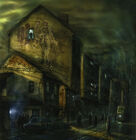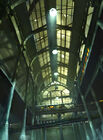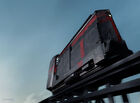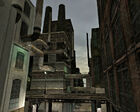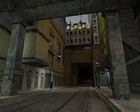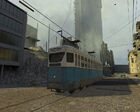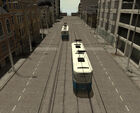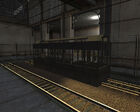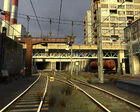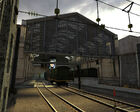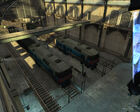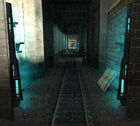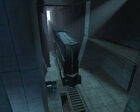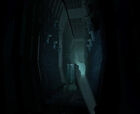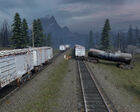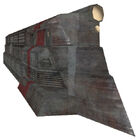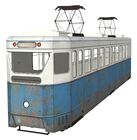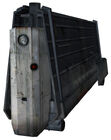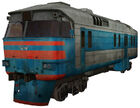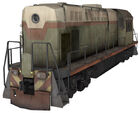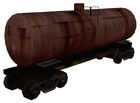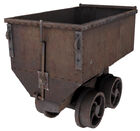Rail transport, such as trains, trams, monorails, railway tracks, and train stations, are recurring themes throughout the Half-Life series. At numerous points in every one of the games (excluding Portal), the player encounters one or more moving or stationary locomotives, lone carriages, or full-length coupled trains. There are also several instances where the player must cross or follow railway tracks, either on foot, non-rail vehicle, riding in or on the train itself, or by use of an electric monorail, the latter a prominent feature in the original Half-Life game.
Types of rail vehicles[]
Half-Life and its expansions[]
- Black Mesa uses two main types of monorail. One is provided for the security and convenience of the Black Mesa personnel, and rides along the Black Mesa Transit System. The second is a freight monorail used in the Sector E Materials Transport.
- Regular trains are used to bring supplies to the Black Mesa Research Facility using the New Mexico Railroad Line. This is managed in Black Mesa's Freight Yard predominantly featuring freight trains.
Half-Life 2 and its episodes[]
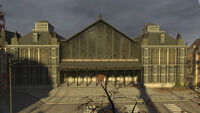
The City 17 Trainstation.
- Three trainstations are featured in Half-Life 2 and its episodes: the City 17 Trainstation and the Depot in Half-Life 2 and the Technical Trainstation in Episode One, although the Citadel also features a train depot.
- The Combine heavily use the existing railway. They mostly use it for troop and Stalker transport in Combine-designed Razor Trains. Also, old existing human trains are recycled for Citizen transportation among the Combine-ruled cities, the Combine recycling human technology for their needs. Gordon Freeman awakes in such a train at the start of Half-Life 2.
- The train in which the player arrives in City 17 is pulled by a railcar based on the DR1A DMU railcar produced in Riga, Latvia. Coupled with units from a different train, it is used by the Combine like a locomotive. The DR1A and its modifications (DR1P, DR1B, etc.) are common DMU trains in post-Soviet countries (Russia, Belarus, Ukraine, Latvia, Lithuania, Estonia, etc.). However, the DR1A in-game have sound files taken from the EMD 645 engine and is seen with ElectroMotive#Blomberg-B BogieTrucks.
- The freight train locomotive seen in Episode Two seems to be based on the Russian TEM2 diesel-electric freight locomotive.
- The train using the railway linking Combine outposts located in the Wasteland is called the "Wasteland Train".[1]
- Train tracks can also be found in Ravenholm, and a track-mounted Zombie defense is present in a small mining section between the town and Shorepoint.
- In Episode One, Gordon and Alyx leave City 17 on a regular train as the Citadel Core explodes. In Episode Two, their train has crashed in the Outlands.
- The Victory Mine complex features an old mining network where rusty carts can be found.
- All trains have EMD 645 engine sounds, which is commonly heard these days on freight trains in North America.
Railways as a literary device[]
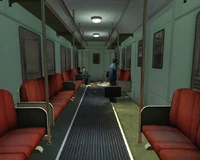
Citizens on a train on its way to the City 17 Trainstation at the very start of Half-Life 2.
Railways, along with roads, rivers, and other paths, have long been used in literature and visual arts as a device representing a journey taking place, such as the railway in the film Stand By Me, or the River Congo in Joseph Conrad's novella Heart of Darkness.
Valve might have not intended this consciously when developing the environments with which the characters interact, but the effect of the motif's appearance throughout the series is a constant symbol and reminder of the long and often difficult journey each character is making as the games progress. The implications of these journeys often include an "inner journey" that each character undertakes parallel to the physical one, emerging at the end having gained something metaphysical, like a greater sense of self, a broader understanding of the world, or inner and outer strength.
In the Half-Life series, Gordon Freeman, because of the circumstances he finds himself in, is forced to be brave and strong, and endure tasks he was not prepared to undertake. In this way, he follows a "path" throughout his experiences, and is a stronger person for it.
What is known is that the player's path through the train station was meant to play a role similar to that of the train ride in Half-Life, i.e. reveal the story setting to the player. In Half-Life 2, the story would unfold at the player's own speed, rather than on a fixed rail, and come about through interaction with the characters naturally found in that setting.[1]
Behind the scenes[]
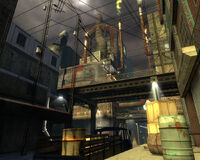
The streets among the Combine Factories, featuring an elevated railway for the Razor Train.
- The railway theme was decided to be a major theme along the Coast very early in the development of Half-Life 2, although it was initially even more present.[1]
- At some point, Gordon was to ride along the coast on a train; a story fragment has his train crashing near the Air Exchange, meeting Alyx and Skitch there and being attacked by the Combine. While Gordon rides the Coast with the Buggy and on foot, the idea was kept for Alyx who arrived at the Depot by train.[1]
- An elevated railway for the Razor Train bringing Citizens into City 17 (a normal terrestrial train in the final version) was to cross the Combine Factories.[2]
- City 17 was originally to feature trams; one tram can be found in the E3 map "
e3_c17_02". Parts of that map were recycled in the Half-Life 2 map "d3_c17_13", the last map of the chapter "Follow Freeman!", where tracks and a shelter can still be seen. Furthermore, an early test map, "prefab_streets_blvd.vmf", features a boulevard with trams going in both directions.[2] - Before trams, school buses were to be used as the primary local transportation.[2]
Gallery[]
Concept art[]
wasteland_railbridge.vmf").wasteland_depot_inside.vmf".Screenshots[]
c17_plaza06.vmf", a predecessor of the map "e3_terminal.vmf".Models[]
List of appearances[]
- Half-Life: Day One (First appearance)
- Half-Life
- Half-Life: Opposing Force
- Half-Life: Blue Shift
- Half-Life: Decay
- Half-Life 2
- Half-Life 2: Raising the Bar
- Half-Life 2: Deathmatch (Non-canonical appearance)
- Half-Life 2: Episode One
- Source Particle Benchmark (Game files only) (Non-canonical appearance)
- Half-Life 2: Episode Two
- Portal 2 (Mentioned only)
References[]
See also[]
External links[]
- "Trains In Games - Half Life 2" on TrainInGames.com
| Black Mesa transportation | Black Mesa SUV • Black Mesa Transit System • Black Mesa truck |
|---|---|
| Black Ops vehicles | AH-64 Apache • M35 cargo truck • V-22 Osprey (cut) |
| HECU vehicles | AH-64 Apache • F-16 Fighting Falcon • M1A1 Abrams • M2A3 Bradley • M35 cargo truck • V-22 Osprey |
| Combine vehicles | Advisor Platform • AirEx Truck (cut) • Armored Personnel Carrier • C-130 (cut) • Combine SWAT Truck (cut) • Hunter-Chopper • M2A3 Bradley (cut) • Merkava (cut) • Razor Train • School Bus (cut) • V-22 Osprey (cut) |
| Resistance vehicles | Airboat • Borealis (cut) • C-130 (cut) • Jalopy (cut) • Jet Ski (cut) • Mil Mi-8 • Muscle Car • Scout Car • Submarine (cut) • V-22 Osprey (cut) |
| Trainstations | City 17 Trainstation • Depot • Technical Trainstation |
| Other | Borealis • Chevrolet Caprice (cut) • Digger (cut) • F-117 Nighthawk (cut) • Ford F-250 (cut) • GMC Vandura (cut) • Rail transport • Road transport |


